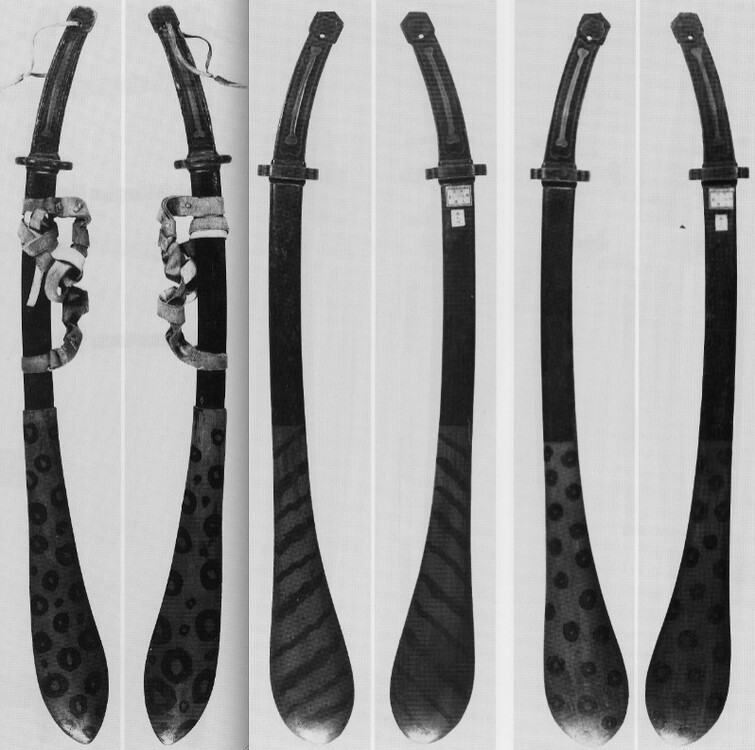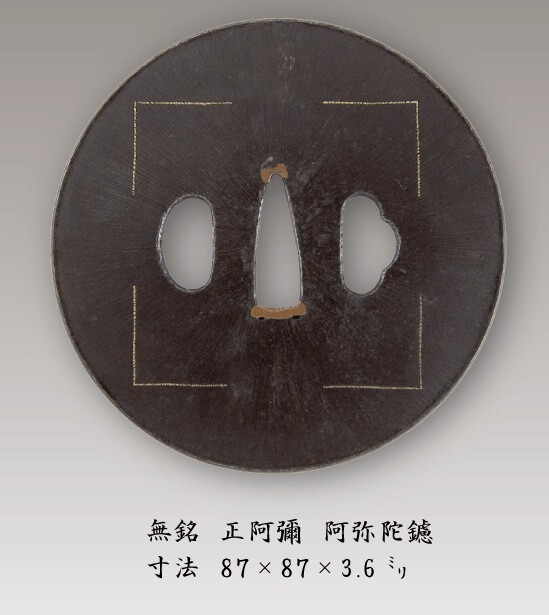-
Posts
779 -
Joined
-
Days Won
1
Content Type
Profiles
Forums
Events
Store
Downloads
Gallery
Everything posted by reinhard
-
I'm sharing Mr Helm's sense of humour in this particular case. reinhard
-
-
That's no big secret. Read English Token Bijutsu magazine vol.7, page 29, published in 1980. It's news from the day before yesterday. And guess what? There are false Juyo Bijutsuhin papers as well, dating from the same time. They are easy to detect (if you know what to look for) and there's not even a need to cross-check with the nado zufu. reinhard
-
Ford, thanks for finally presenting your detailed view of Goto ICHIJO and Kinko during bakumatsu and later times. At least that's something to start with and much better than just mumbling of "some circles". Moreover, and this is certainly not addressed to Ford, top-level artistry needs to be studied IN HAND. What is true for good blades is true for good tosogu as well. You haven't seen the real thing until you saw the object with your own eyes. There is no such thing as a "virtual appreciation" of masterpieces when it comes to real art. Colors changing when light and angles of view change, supreme qualitiy of surface finish and many other features, most of the magic actually, can't be seen in pics. You may study hi-res pics of masterpieces until your eyes pop out. Still you haven't seen anything yet. reinhard
-
No surprise at all. "Some circles" cultivating their whimsical opinions can be found easily all over the world. So what? reinhard
-
What exactly do you mean by "the best"? I must admit "Dojigiri YASUTSUNA" and "Mikatsuki MUNECHIKA" were not for sale this year, but apart from national treasures on a Tenka Goken-level the selection of MeiTo at DTI was quite impressive, don't you think? I remember four top-class KIYOMARO blades and one of the most beautiful NAGAMITSU tachi (JuBi) at Eiwado's shop. Taibundo's swords were of no lesser qualities. I remember handling a very rare zaimei Ko-Aoe KORESUKE tachi with beautiful mei and one of the best Ayanokoji blades in existence there. Bob Hughes offered a beautiful Rai KUNITSUGU with outstanding koshirae. Not to speak of the marvellous top-class swords offered by Sokendo, Seikado, Seikeido...So what are you talking about exactly and which ones are these "little shops" you are talking about? True, not all treasures were displayed on tables at DTI, but compared to the level of most discussions on NMB and compared to sword-shows elsewhere, especially outside of Japan, DTI was and is a most impressive experience. reinhard
-
I heard he is a Kami by now. Can't remember the shrine where he is worshipped though. Allow me to go outside for a laugh, if you please. So much for NTHK promo on NMB. reinhard
-
This is getting slightly off-topic, but so what. Don't worry, Henry, the tsuba arrived sound and safe at the other end of the world and you will be the first in line to be asked in case I will ever want to separate from it. BTW It made me reconsider the standing of Shonai Kinko compared to schools with higher reputation. It was a pleasure meeting you and other familiar faces at DTI again, as well as seeing the real faces behind the avatars of the French Connection (Jean & Jacques and some others). NMB as a virtual playground is quite nice, but it can't compete with real life. Wish to see you next year again reinhard aka Popeye Doyle
-
Got some "irresistible" offers from Guido's mail account as well. Must be a Hotmail thing (no wonder). Get yourself a reasonable mail-account, Guido! BTW, it was a pleasure meeting you again at DTI. reinhard
-
Where's Mr.Hallam when you REALLY need him? reinhard
-

this is quite a challenge, for me anyway...
reinhard replied to W K Clifford's topic in Translation Assistance
Show us the Juyo example, if you please. reinhard -
Quoting from the commemorative centenary edition of "Hawley's Japanese swordsmiths": "Six months went by, then a year. Finally one blade surfaced at a gun show on the East Coast. It had been bought by a collector who upon further examination once home, determined it to be one listed as stolen from the Hawley collection. The collector returned the sword to Willis gratis. Then...nothing. Willis was devastated but he was also disgusted that collectors would collect so dishonorably." Things haven't changed yet. I'm talking of the collection of swords of the late Mr. Indlekofer in Riehen, Switzerland. They were stolen in April 2003. All these swords are well-documented Juyo Token and they are still out there somewhere. reinhard
-

this is quite a challenge, for me anyway...
reinhard replied to W K Clifford's topic in Translation Assistance
That's it. reinhard -

this is quite a challenge, for me anyway...
reinhard replied to W K Clifford's topic in Translation Assistance
I forgot to mention: What does it mean when the extension of the shinogi into the nakago looks like this? See the area around "Murasame". It's a textbook-example of .....? reinhard -

this is quite a challenge, for me anyway...
reinhard replied to W K Clifford's topic in Translation Assistance
Yimu, let's waste some more time. The mei on your sword looks like a pretty poor promo-stunt, but I won't tell you why. You have to find out by yourself since you seem to know enough about Japanese swords already. As you probably know, the Ikoma in Sanuki possessed some very fine and famous swords and quite a few were marked with "Ikoma Sanuki-no-Kami". Here's a pic of a kinzogan-mei on a real sword from the Ikoma-collection (presently in the possession of the Kurogawa institute). Can you see the difference? reinhard -
Brian concluded very well what I was saying. Reading my posts carefully, you will notice that I wasn't talking about retempering of NihonTo in general, not even about yakinaoshi of so-called "top-level swords". It was all about a very small group of swords treasured by daimyo or even by the shogun or by the imperial court itself. Kogarasu-maru", celebrated heirloom of the Taira clan, is a very good example. Others could be named like the "Tenka-Go-Ken" or some of the treasures possessed by families like the Tokugawa, the Uesugi, the Maeda, the Shimazu, the Kuroda, to name a few. The swords I'm talking about are representing the very best works of famous masters from old and many of them were recognized as masterpieces beyond weapons from the start. It doesn't take a genius to understand, why these few swords I'm talking about were not used in battle anymore soon after their manufacture. All it takes is a small understanding of how Japan worked during feudal times and getting rid of romantic images. MASAMUNE f.e. is said to have worked for the bakufu in Kamakura directly. Believing that his swords were sold to common warriors is just naive (politely said). You won't find it all in the web though. For those who are trying to practice sarcasm, like Keith, I recommend the reading of more sophisticated books than those you'll find on lists for beginners. - Unfortunately I don't have the time to hold elaborate lectures here. reinhard
-
Clive, most of the best swords in the history of NihonTo were recognized as masterpieces and works of art (sic!) almost instantly. Many of them were made for famous personalities/families in the first place anyway. These swords were taken out of the grinding process of battles at a very early stage and were bestowed upon high-ranking personalities. This is the reason why so many of the greatest Japanese swords survived in excellent, even pristine condition. It wasn't all about sword-care, although sword-care was (and is) important, of course. - It was crystal-clear, even before the fall of Osaka castle, that no Shogun, Daimyo or any other high-ranking samurai would ever have to wield "Ichigo Hitofuri" in battle again. While retempering this particular sword, shodai YASUTSUGU was free to focus on the artistic details of the blade alone. reinhard
-
This reminds me of an episode of "two and a half men": After partying heavily with a bunch of gothic babes, Charlie Harper discovers a pentagram on his belly the next day. His question, adressed to his brother Alan, is: "Am I Jewish now ?" I know, I know, too cryptic again. reinhard
-
And again we're in the midst of a "art vs. artefact" discussion. For consideration: The famous "Ichigo Hitofuri"-tachi by Awataguchi YOSHIMITSU was retempered by shodai YASUTSUGU (not exactly an "unknown hand") after it was unfortunately damaged by fire at the fall of Osaka castle. This particular yakinaoshi had not been done in order to restore the blade's weapon-qualities, for Ichigo Hitofuri was a legend and far beyond practical use by then. A tachi by Sanjo CHIKAMURA from late Heian-period was designated Juyo Token although its yakiba is yakinaoshi. Its genuine mei "CHIKAMURA tatematsuru" is of such (historical) importance that will compensate the loss of genuine workmanship. Basically I agree with Chris reinhard
-
A most interesting logic here, "Soten_Fan". Do you have a real name? reinhard
-

Definition of the term, Keiba Dachi
reinhard replied to sanjuro's topic in General Nihonto Related Discussion
Attached are three examples from the Tokyo National Museum. Description is always the same: They were made between 15th and 18th century for ceremonial horse-race. There's not much of a secret as it seems. It was a kind of standard for three hundred years to be worn on this particular occasion. This kind of koshirae was usually made with a kenuki-gata handle. The one in the Itsukushima shrine depicted by Moriyama-san seems to be special and of a more elaborate kind than the ones in the TNM. reinhard -
My little Hobbit-friends, You can post a hundred pics more, but in a case like this they won't prove anything. Let's wait and see. Wether it's just a Soshu-style blade or a genuine YUKIMITSU can only be told by a person who did see the more important swords by YUKIMITSU in hand. There are only very few who can. Until then you'll just have to wait. reinhard
-
For consideration: The fame of early Soshu masters like MASAMUNE and YUKIMITSU is mainly resting on the particular quality of nie on their blades. It is sheer magic when seeing it in hand and cannot be depicted appropriately by photographs. All attempts have failed so far. In order to get a reasonable judgement on a possible YUKIMITSU blade you either need to compare it with a safe example you have seen yourself or you need an expert who did so. Anything else is just speculation. BTW Hon'ami Koson is not considered to be a landmark in the field of appreciation of NihonTo anymore. reinhard
-







